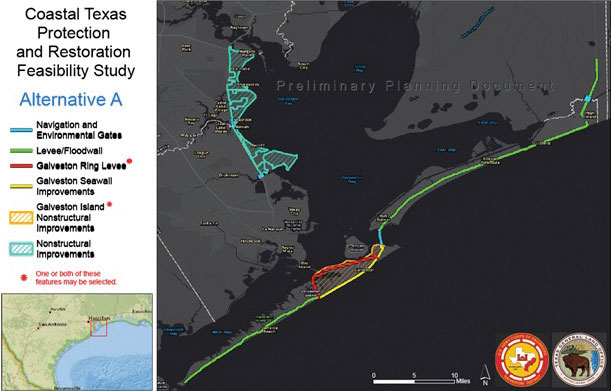Page 1: Rationale for Storm Barrier
Page 2: A Storm Barrier a Good Investment
Page 3: An Alternative Strategy: Galveston Bay Park Plan
A Storm Barrier a Good Investment
Mitchell agrees that Congress needs to allocate more funding for infrastructure and for protections against worsening climate: “It’s absolutely correct that we need more funding for critical infrastructure projects that include defending from storm surges, flooding, and from changes in the climate. While I believe that the $12 billion for Texas provides the biggest bang for the buck, I recognize that other cities and communities are being faced with growing challenges to their infrastructure. These issues need to be addressed.”

Mitchell says there were protests about the early design of some storm surge barriers because they would have been built in front of houses along the coast and have a negative impact among property owners along the Bolivar Peninsula and elsewhere. In response, “the plan was adjusted to follow the lead of the Netherlands by expanding revetments and building up the barrier protections through expanding beaches and allowing for the gradual incline of dunes to jut out into the Gulf of Mexico. This provides a more natural barrier that complements the topography of the coastline and does not negatively impact home and property owners. It will require, just as in the Netherlands, the deployment of dredging vessels to transport sediment and sand to spray along the coastline and to build up these barriers along the coast.”
The storm surge barrier, is a good investment, according to report published by two Texas A & M professors entitled “Economic impacts of storm surge and the cost-benefit analysis of a coastal spine as the surge mitigation strategy in Houston-Galveston area in the USA” which they summarized in a 2019 article.
The study authors are Meri Davlasheridze, an assistant professor at Texas A&M University, Galveston who focuses on the economics of natural hazard impacts and mitigation, while Wesley Highfield an associate professor at Texas A&M University, Galveston focuses on the analysis and mitigation of natural hazards.
Davlasheridze told AJOT that the report looked at a number of different scenarios and found that the Galveston Bay storm barrier would substantially benefit the region by mitigating the effects of storm surges from hurricanes such as from Hurricane Ike in 2008 and Hurricane Harvey in 2017.
She noted, however, that the likelihood of a 500-year storm surge event is increasing and that damage will worsen with higher sea levels in the future.
In the July 2019 summary entitled ‘Coastal spine could lessen impact of most hurricanes,’ the professors looked at the impact of damage to residential property in the Houston/Galveston areas that included Harris, Galveston and Chambers counties and found: “The presence of a coastal barrier reduced damage from storm surge-based flooding by between 70 and 90 percent. These percentage figures represent between $423 million for a smaller, more likely hurricane, to $5.6 billion for a larger, less likely hurricane. For a storm that mimics the surge of Hurricane Ike, residential property damage was reduced from $2.9 billion to $135 million, a 95 percent loss avoidance.”
Impact to Petrochemical Plants
When the study was expanded to include the economic impacts of storm surges on petrochemical plants in the Houston area, the researchers found: “The addition of petrochemical and industrial plants adds structures worth between $8.7 billion and $17.5 billion that are exposed to storm surge. Further, because many plants on the coastline are forced to shut down because of the threat of a storm alone, irrespective of damage, additional indirect costs are incurred…. For the most conservative scenario of an 18-day shutdown, total losses range from $400 million for a likely hurricane, to $13 billion for a lower probability storm.”
The study found that “these effects are significantly mitigated with a coastal barrier: a 100 percent reduction in total losses for smaller storms to a 76 percent reduction in larger, less likely storms.”
The researchers looked at the long-term economic impact to the Texas economy. They noted that “economic effects of a storm surge are not isolated to the area flooded by the surge: “Our local and regional economy is intricately linked to economies in other regions and states, and the ripple effect shows up in Texas’ and the nation’s gross domestic product, among other measures.”
The researchers found: “when considered over a 50-year time frame, our projections show that without coastal protection, storm surges are likely to decrease Texas’ Gross State Product by 8 percent — which is to say, $863 billion.”
As a result, “a coastal spine substantially mitigates these economic impacts. Further, all macroeconomic indicators — except for government expenditures — will also decline, with the value of net exports suffering the most profound decline by an estimated 13 percent, corresponding to $160 billion loss.”

Follow us on social media: